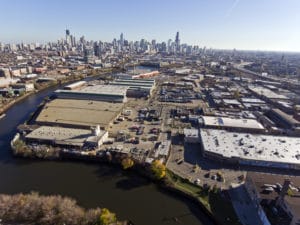Chicago Area Selected as Study Site for 2017 ULI Hines Student Competition
Graduate Student Teams Challenged to Design Master Plan Development for Area Surrounding City’s Fleet and Facility Management Headquarters
WASHINGTON (January 10, 2017) – An area adjacent to the North Branch of the Chicago River has been selected as the study site in the Urban Land Institute’s (ULI) 15th annual ULI Hines Student Competition. The ideas competition – based in reality with certain details changed for the purposes of the challenge – provides both full- and part-time graduate-level student teams the opportunity to devise a comprehensive design and development program for parts of a real, large-scale site. The team with the winning proposal will receive $50,000; the winner will be announced in early April.
This year’s competition is based on a hypothetical situation related to the actual 2016 announcement by Mayor Rahm Emanuel that the Chicago Department of Fleet and Facility Management will be relocating their headquarters from the site near Goose Island. The competition’s challenge for students involves an investment group, known as the Windy Crew Investors (WCI), which has assets in the study area next to North Branch. This investment group is seeking a master developer to create a successful bid for building a mixed-use sustainable area that benefits from adjacent synergies in the vacant property near Goose Island. Playing the role of the potential master developer, student teams must the evaluate the benefits and financial possibilities of buying the Fleet Management and Facility site, and potentially combining it with certain parcels to redevelop or sell as one comprehensive development site.
The competition, which starts today, is designed to simulate an actual urban planning and development scenario. The competition allows each team of five students 15 days to design and submit a master-plan proposal that includes presentation boards with drawings, site plans, tables, and market-feasible financial data. Embodying the complex nature of an actual urban planning and development scenario, student teams must be multidisciplinary and reflect at least three different urban design and development disciplines.
Though based on a hypothetical situation, the 2017 Hines Student Competition reflects many real-life initiatives and concerns of Chicago. Mayor Emanuel’s administration has taken a proactive approach, including encouraging corporations to locate downtown and catalyze economic development in some of the city’s struggling inner-city neighborhoods. However, obvious challenges remain in connecting downtown and the surrounding neighborhoods, including improving transit efficiencies, adapting to the city’s changing employment base, and improving how community designs work with adjacent properties.

The Fleet Management facility located on Chicago’s north side. Image: ULI/Nathan Weber
This year, applications were submitted by 130 teams representing nearly 60 universities in the United States and Canada. Teams participating in the competition must submit proposals that illustrate innovative approaches to five general elements: 1) planning context and analysis, 2) a master land use plan, 3) urban design, 4) site-specific illustrations of new development, and 5) development schedule and finances. Participants have received project briefing materials, including a comprehensive statement of the challenge, background information on the site, market information, relevant existing design proposals, site maps and photos, and other details, along with a list of materials required for team presentations. The competition is designed as an exercise; there is no intention that the students’ plans will be implemented as part of any revitalization of the site.
Project proposals must be submitted to ULI headquarters by January 23, 2017. A jury will review all proposals in compliance with the deadline and select four finalist teams and several honorable mentions. The finalists and honorable mentions will be announced in late February. During the final phase of the competition in March, the student finalist teams will have the opportunity to expand their original schemes and provide more detail for their plans. During this time, one member of each finalist team will receive an all-expenses-paid site tour of the Chicago site (though other team members may also join the tour). Information obtained during this site visit can then be used by the finalist teams in revising their presentations prior to the final presentation in April. During the April finale event, finalist team members will present their schemes in-person to the competition jury during a public forum in Chicago. A $50,000 prize will be awarded to the winning team, with $5,000 of the total going to the school. Each of the remaining three finalist teams will receive $10,000.
The Hines Student Competition is part of an ongoing ULI effort to raise interest among young people in creating better communities and improving development patterns, as well as increase awareness of the need for interdisciplinary solutions to development and design challenges. The competition is strategically structured to encourage cooperation and teamwork—necessary talents in the planning, design, and development of sustainable communities—among future land use professionals and allied professions, such as architecture, landscape architecture, urban planning, historic preservation, engineering, real estate development, finance, psychology, and law. It is open to graduate students who are pursuing real estate–related studies at universities in the United States and Canada, including programs in real estate development, urban planning, urban design, architecture, and landscape architecture. Jurors for competition represent a strategic mix of land use experts, including developers, brokers, architects, urban designers, landscape architects, urban planners, and policy officials, among others.
The competition has been funded through an endowment from Gerald D. Hines, chairman of the global Hines real estate organization and a recipient of the ULI J.C. Nichols Prize for Visionaries in Urban Development. A legend in the land use industry, Hines is widely known as a leader who pioneered the use of high-quality planning and architecture as a marketable feature of development in office, residential, and mixed-use projects. Since the first competition was held in 2003, more than 7,500 students have participated.
For more information on the ULI Hines Student Competition, visit uli.org/hines.
About the Urban Land Institute
The Urban Land Institute is a nonprofit education and research institute supported by its members. Its mission is to provide leadership in the responsible use of land and in creating and sustaining thriving communities worldwide. Established in 1936, the institute has nearly 40,000 members worldwide representing all aspects of land use and development disciplines. For more information, please visit uli.org or follow us on Twitter, Facebook, LinkedIn, and Instagram.
Contact Robert Krueger at 202-624-7051






